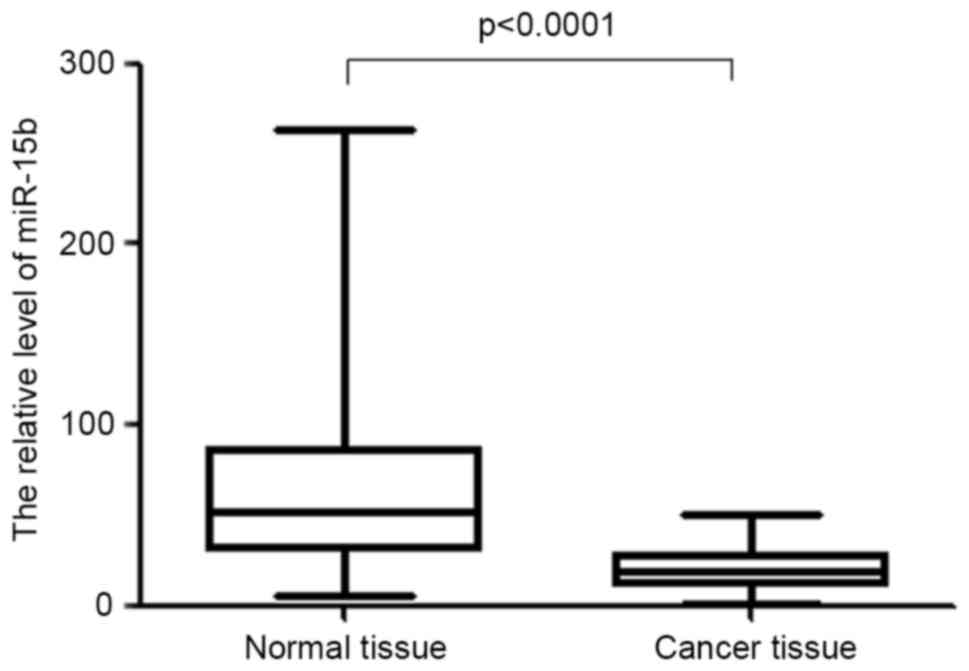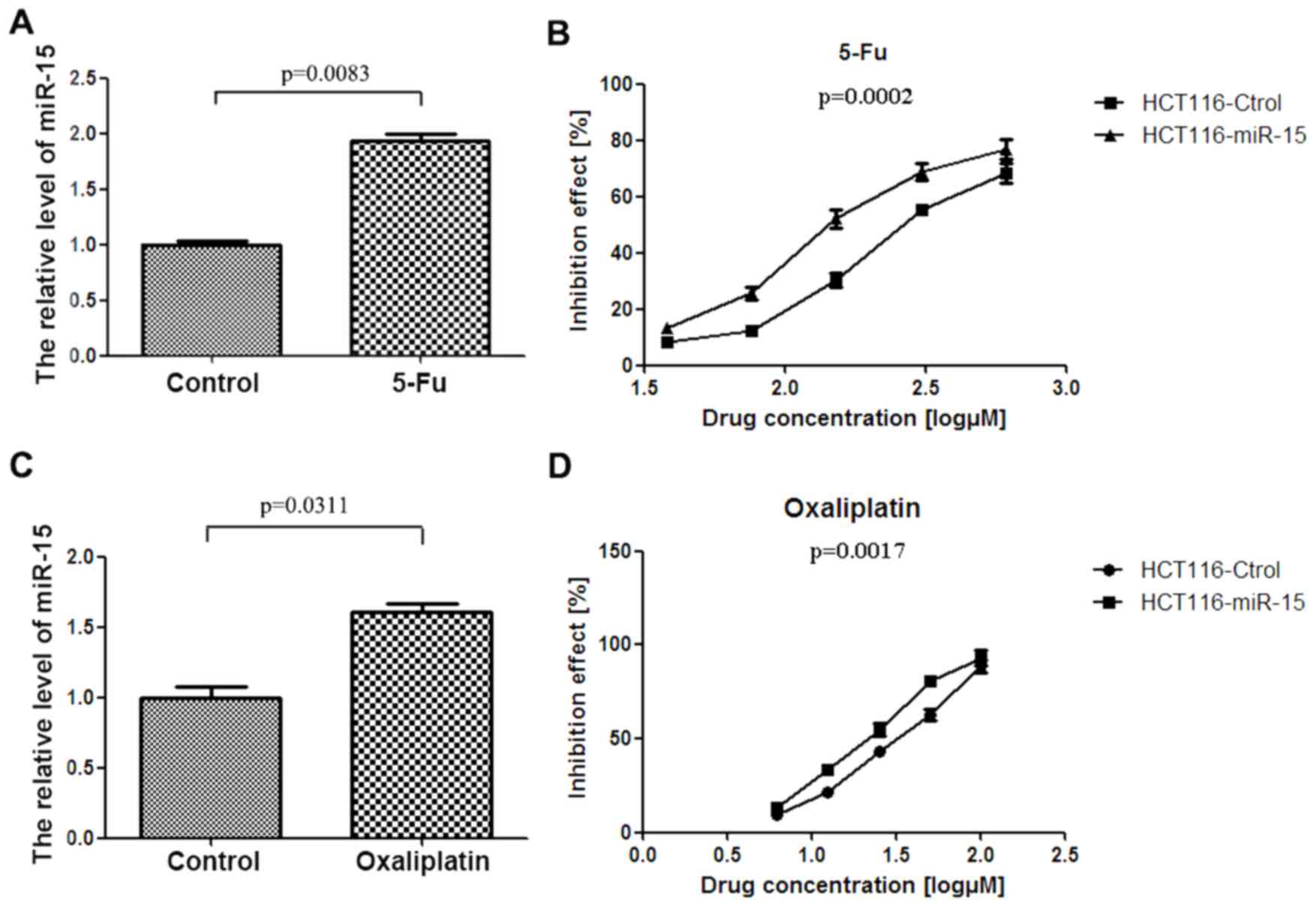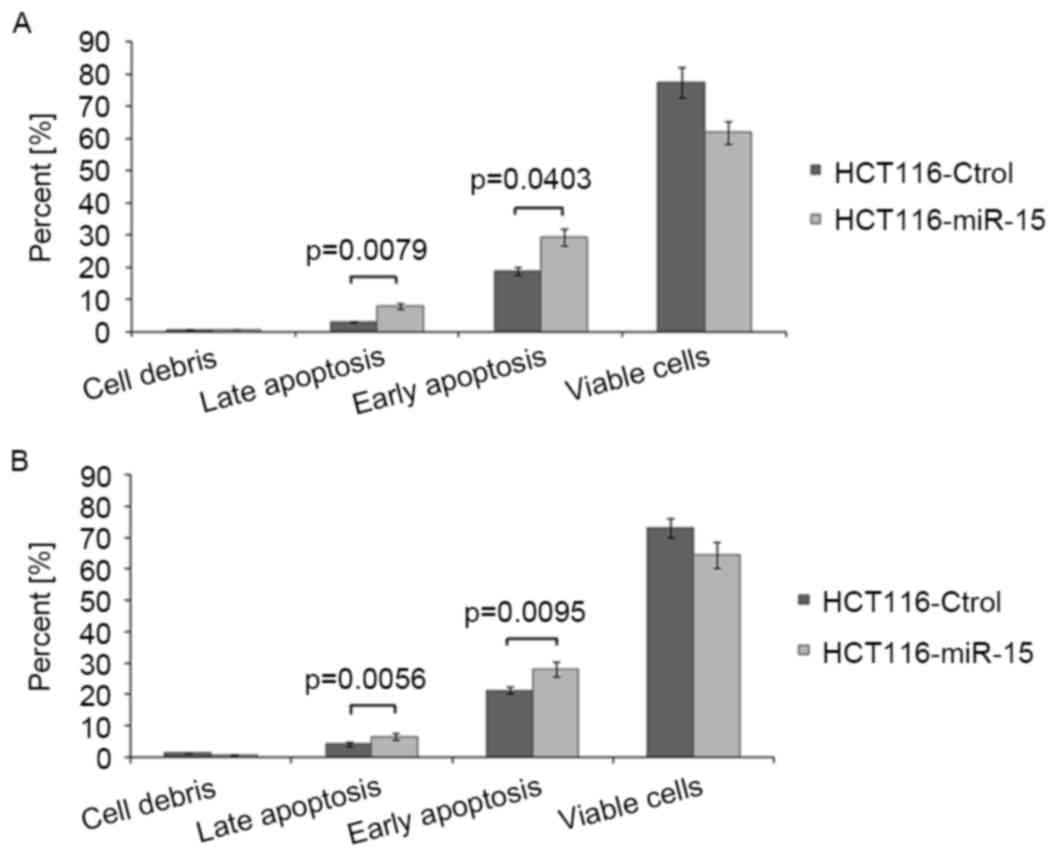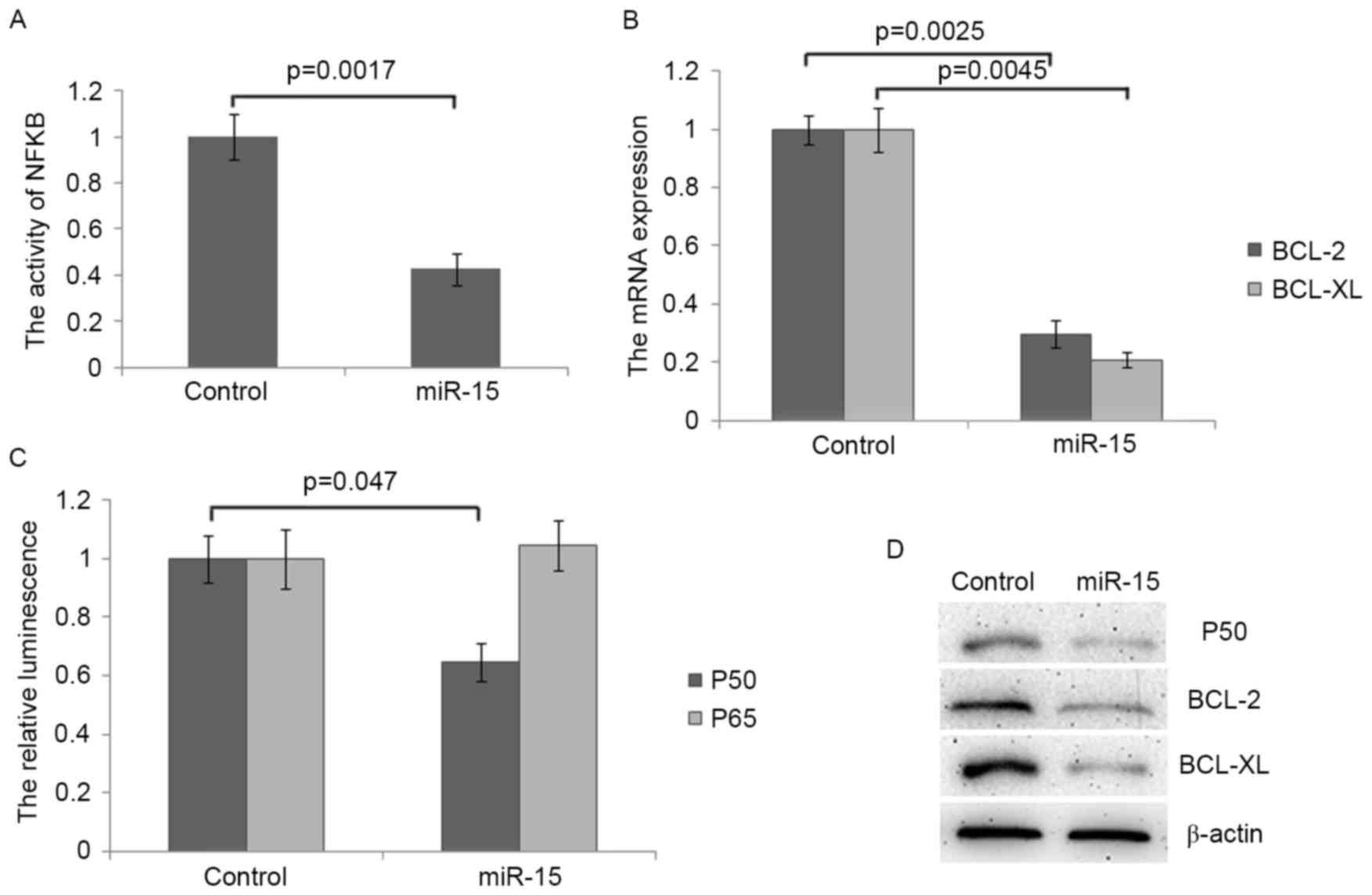Overexpression of microRNA-15 increases the chemosensitivity of colon cancer cells to 5-fluorouracil and oxaliplatin by inhibiting the nuclear factor-κB signalling pathway and inducing apoptosis
- Authors:
- Published online on: December 22, 2017 https://doi.org/10.3892/etm.2017.5675
- Pages: 2655-2660
Abstract
Introduction
Colon cancer is one of the most common (1). In recent years, improvements in early screening techniques and treatment strategies has largely decreased the morbidity and mortality of colon cancer in the United States (1). However, these regions do not include developing countries such as China. Furthermore, the incidence is increased in younger patients (2). Previous studies have focussed on early diagnosis and clinical treatment of colon cancer (3,4), however, the mechanism of action remains unknown. Therefore, investigating the mechanism of colon cancer has important practical significance.
microRNAs (miRNAs) are a class of small non-coding RNAs that are 19–25 nucleotides long (5). They regulate gene expression by binding to their target mRNAs, resulting in the degradation of mRNA or repression of mRNA translation (6). Previous studies have reported that miRNAs are involved in the development of cancer (7) and serve a role in the development of chemotherapy resistance in different tumours (8,9). Therefore, targeting miRNAs may be developed as a novel method of treating cancer and improve the responses of patients to chemotherapy.
miR-15 is a miRNA that has been extensively studied. miR-15 is aberrantly regulated in various types of cancer and is associated with cell proliferation, angiogenesis and metastasis (10). However, the role of miR-15 in cancer remains unclear. Some studies have suggested that miR-15 functions as an oncogene, whereas others regard it as a tumour suppressor (11,12). The effects of miR-15 on chemotherapy are also inconsistent (13,14) and to the best of our knowledge, there have been no studies investigating the potential effect of miR-15 on colon cancer chemotherapy.
In the current study, miR-15 was detected in matching colon cancer and para-carcinoma tissues, the effect of miR-15 on colon cancer chemotherapy was analysed and its associated mechanism of action was investigated. These results may improve understanding of the process of chemotherapy resistance and the search for potential intervention targets.
Materials and methods
Patients
In the present study, miR-15 was detected in 62 paired colon cancer and para-cancerous colon tissues collected from patients who underwent surgical resection to treat colon cancer at Linyi People's Hospital (Shandong, China)between May 2011 and December 2014. The mean range of the enrolled patients was 50.8±16.4 years old (range, 34–65 years) and the male-female ratio was 42:20. The final diagnosis for each patient was confirmed by two double-blinded pathologists. Following resection, the tissues were rapidly frozen and stored in liquid nitrogen. All procedures performed in the present study that involved human participants were in accordance with the ethical standards of the institutional and/or national research committee, and with the 1964 Helsinki Declaration and its later amendments or comparable ethical standards. The current study was approved by the Ethics Committee of Linyi People's Hospital (Linyi, China) and informed consent was obtained from all participants.
Cell culture and transfection
Human colorectal carcinoma HCT116 cells (Cell Center of Institute of Basic Medical Science, Chinese Academy of Medical Science, Shanghai, China) were cultured in Dulbecco's Modified Eagle's Medium (Hyclone; GE Healthcare, Logan, UT, USA) supplemented with 10% fetal bovine serum (GIBCO; Thermo Fisher Scientific, Inc., Waltham, MA, USA), 100 U/ml penicillin and 100 µg/ml streptomycin at 37°C in a humidified atmosphere containing 5% CO2 and 95% air.
HCT116 cells were plated in 6-well plates (1×105/per well) and the chemosynthetic miR-15 mimics (Invitrogen; Thermo Fisher Scientific, Inc., Waltham, MA, USA) were transfected into cells using Lipofectamine™ 2000 (Invitrogen; Thermo Fisher Scientific Inc.) following the manufacturer's protocol. The scrambled sequence was used as negative control (Invitrogen; Thermo Fisher Scientific Inc.). The concentration of miR-15/NC was 50 nmol/l in each well.
Reverse transcription-quantitative polymerase chain reaction (RT-qPCR)
Total RNA was isolated from frozen tissues or cells using TRIzol® (Invitrogen; Thermo Fisher Scientific Inc.) and reverse-transcribed into cDNA. In brief, 5× RT buffer (4 µl), primer (0.1 µg), 10 mM dNTPs (1 µl), RNA sample (1 µg), transcriptase (1 µl), and RNAase-free water (20 µl) were mixed. The mixture was incubated at 25°C for 5 min, 42°C for 30 min, 85°C for 5 min and then stored at 4°C. All above reagents were supplied by Takara Biotechnology Co. Ltd, (Dalian, China) SYBR Green PCR Mastermix (Takara Biotechnology Co. Ltd) was used to perform qPCR. PCR conditions were as follows: denaturation at 96°C for 3 min, 35 cycles of amplification at 94°C for 10 sec/cycle and then 58°C for 30 sec. miR-15 expression was normalized to that of U6, whereas levels of nuclear factor-κB (NF-κB), B cell lymphoma-2 (BCL-2) and B cell lymphoma-extra large (BCL-XL) mRNA were normalized to that of GAPDH. Expression level was analyzed using the 2−∆∆Cq method (15). The primers (Takara Biotechnology Co. Ltd) for PCR are presented in Tables I and II.
Luminescent cell viability assay
The cells transfected with miR-15/NC (1×104/per well) were seeded into a 96-well plate and treated with 5, 10, 20, 40 and 80 µg/ml 5-Fluorouracil (5-Fu, Tjkingyork company, Hangzhou, China) or 2.5, 5, 10, 20, 40 µg/ml Oxaliplatin (OX, Zhejian Hisun Pharmaceutical Co., Ltd, Zhejiang, China) for 48 h at 37°C. Cellular viability was measured using Cell Titer-Glo™ (Promega Corporation, Madison, WI, USA) following the manufacturer's protocol.
Measurement of apoptosis by flow cytometry
Flow cytometry (BD Biosciences, Franklin Lakes, NJ, USA) was used to detect the apoptosis of cells transfected with miR-15 or-NC and treated with 5-Fu or OX. The apoptosis kit was obtained from BD Biosciences. Propidium iodide and Annexin V-fluorescein-isothiocyonate stains were used to measure late and early apoptosis, respectively. The stains were incubated for 15 min at room temperature in the dark.
Plasmid construction and dual-luciferase assay
To generate the luciferase reporter with NF-κB activity, the canonical NF-κB recognising sequence (GGG RNN YYC CGG GRN NYY CC) was synthesized and inserted into the promoter region of the pGL3 basic vector (Promega Corporation) lined with MluI and XhoI. To measure the interaction between miR-15 and its target mRNAs, the sequence containing predicted target sites within the p50 or p65 mRNAs was synthesized and cloned downstream of the firefly luciferase coding region in the pGL3 control vector (Promega Corporation) lined with SacI and HindIII. The plasmids and miR-15 or NC were co-transfected into HCT116 cells using Lipofectamine™ 2000 (Invitrogen; Thermo Fisher Scientific Inc.) following the manufacturer's protocol. At 24 h post-transfection, cells were lysed and luciferase activity was measured using a dual-luciferase reporter test kit (Promega Corporation, Madison, WI, USA). The normalization was completed by comparison with Renilla luciferase activity. The primers (Takara Biotechnology Co. Ltd, Dalian, China) were shown in Table III.
Western blot analysis
Protein was extracted from cells transfected with miR-15 or NC using radioimmunoprecipitation assay lysis buffer (Beyotime Institute of Biotechnology, Haimen, China) and protein concentration was determined using the BCA assay kit (Beyotime Institute of Biotechnology). Equal amounts of protein (20 µg/per lane) were loaded onto 12% SDS-PAGE and transferred onto PVDF membranes. The membranes were blocked with 5% skimmed milk powder at 37°C for 2 h. Then, membranes were incubated with primary antibodies (all Santa Cruz Biotechnology, Inc., Dallas, TX, USA), including mouse anti-human p50 (cat no. sc-53744, 1:200), mouse anti-human BCL-2 (cat no. sc-509, 1:200), rabbit anti-human BCL-XL (cat no. sc-7195, 1:200) and mouse anti-human β-actin (cat no. sc-130300, 1:500) at 4°C overnight and they were subsequently incubated with horse radish peroxide-conjugated bovine anti-mouse/rabbit secondary antibody(Santa Cruz Biotechnology, Inc., 1:2,000; cat no. sc-2371/2370) at 37°C for 2 h. An immunoblot was generated using the ECL western blotting detection system (Thermo Fisher Scientific Inc.).
Statistical analysis
All data were presented as the mean ± standard deviation. The gene expression level, apoptotic cells percent, NFKB and luminescence activity between two groups were compared using Student's t test. The chemosensitivity was compared by two-way analysis of variance. Multiple comparisons between the groups was completed using the Student-Newman-Keul's method. SPSS software was used to analyse data (version 10.0; SPSS, Inc., Chicago, IL, USA). P<0.05 was regarded as indicating a statistically significant difference.
Results
miR-15 is significantly downregulated in colon cancer
To determine the role of miR-15 in colon cancer chemotherapy, the expression of miR-15 in cancerous and para-cancerous tissues from 62 patients with colon cancer was measured. The results demonstrated that in the majority of cases (56/62), miR-15 was significantly decreased in cancerous tissue compared with matched para-cancerous tissue (P<0.0001, Fig. 1). The decrease in miR-15 expression in colon cancer tissue may affect the sensitivity of colon cancer tissue to chemotherapy.
miR-15 improves the chemosensitivity of colon cancer cells
To determine the association between chemotherapeutics and miR-15 expression, HCT116 cells were treated with 5-Fu and OX, two reagents commonly used to treat colon cancer, and the change in expression of miR-15 was assessed (Fig. 2). The results demonstrated that miR-15 expression was significantly upregulated in HCT116 cells treated with 5-Fu and OX (P<0.01; Fig. 2A and P<0.05; Fig. 2C).
The effect of miR-15 on the response of HCT116 cells to 5-Fu and OX was detected using a luminescent cell viability assay. The results indicated that miR-15 significantly increased the inhibitory effect of 5-Fu or OX on HCT116 cell viability (both P<0.01; Fig. 2B and D). The half maximal inhibitory concentrations (IC50) for 5-Fu in NC and miR-15 transfected cells were 289.6 µM and 93.99 µM respectively, whereas the IC50 for OX in NC and miR-15 transfected cells were 50.27 µM and 20.07 µM, respectively. These results suggest that miR-15 increases the sensitivity of colon cancer cells to 5-Fu and OX chemotherapy.
miR-15 promotes 5-Fu- or OX-induced apoptosis in colon cancer cells
To determine the possible mechanism of miR-15 increasing chemosensitivity, the level of apoptosis induced by 5-Fu or OX in HCT116 cells transfected with miR-15 was measured. The results demonstrated that the rate of apoptosis was significantly increased in miR-15 transfected cells compared with control cells (P<0.05; Fig. 3) following treatment with OX or 5-Fu. This indicates that miR-15 promotes apoptosis induced by chemotherapeutic agents in HCT116 cells.
miR-15 targets NF-κB and inhibits the expression of its target gene
The activation of NF-κB promotes the transcription of several anti-apoptotic factors including BCL-2 and BCL-XL (16) and it has been demonstrated that miR-15 inhibits the expression of BCL-2 (17). Thus, the current study investigated whether miR-15 inhibited the activation of NF-κB in colon cancer cells. It was demonstrated that the transcriptional activity of NF-κB was significantly decreased in miR-15 transfected cells compared with control cells (P<0.01; Fig. 4A). Following transfection with miR-15, levels of BCL-2 and BCL-XL mRNA, two direct targets of NF-κB exhibiting anti-apoptotic functions, were also significantly decreased (both P<0.01; Fig. 4B). These results suggest that miR-15 inhibits the activation of NF-κB in colon cancer. The potential binding sites for miR-15 within p50 and p65, two subunits of the transcription factor NF-κB, were screened and a potential binding site was identified within the open reading frame of either p50 or p65, which is located between 2,470 and 2,476 nucleotides (nt) and between 1,231 and 1,236 nt in the mRNA of p50 and p65. The results of the dual-luciferase assay demonstrated that miR-15 significantly inhibits the expression of p50 but not of p65 (Fig. 4C). The decrease in the expression of p50 protein following miR-15 transfection was confirmed by western blot analysis (Fig. 4D). Furthermore, the expression of BCL-2 and BCL-XL protein were also decreased in miR-15 transfected cells (Fig. 4D). Taken together, these results indicate that miR-15 increased the chemosensitivity of colon cancer cells to 5-Fu and OX by repressing the NF-κB signalling pathway and promoting apoptosis.
Discussion
Chemotherapy is an important method of treating cancer. A large number of patients with cancer have benefitted from tumour regression and increased survival following the development of various chemotherapeutic agents (18). However, the development of chemoresistance, in which cancer cells exhibit little or no response to chemotherapy drugs, poses a challenge to the treatment of cancer (19).
Previous studies have identified some of the mechanisms of chemoresistance, which include increased drug efflux (20), decreased drug activation (21) and increased DNA repair activity (22). Recently, several studies have indicated the regulatory role of miRNAs in response to chemotherapy (23–25). For example, miR-214 induces cisplatin resistance in certain types of ovarian cancer by targeting the phosphatase and tensin homolog/phosphoinositide 3-kinase/Akt pathway (26). In addition, high levels of miR-378 may reverse the chemoresistance of lung adenocarcinoma cells to cisplatin by inhibiting the expression of secreted clusterin (27). miRNA is therefore an appealing target to increase effectiveness of various drugs.
It has been demonstrated that miR-15 serves an important role in the tumourigenesis of colorectal cancer (10). However, its expression and function remain unclear. Xi et al (28) determined that miR-15 was significantly overexpressed in colorectal cancer tissues and thus may function as an oncogene. By contrast, Wang et al (29) identified that miR-15 was downregulated in colorectal cancer tissues and may act as a tumour suppressor. In the present study, the expression of miR-15 was decreased in the majority of colon cancer tissues compared with para-cancerous tissues, supporting the role of miR-15 as a tumour suppressor in colon cancer.
miR-15 is able to regulate chemoresistance in addition to regulating cell proliferation, apoptosis, angiogenesis and metastasis (30–33). Xia et al (34) identified that miR-15 may enhance the sensitivity of gastric cancer cells to anticancer drugs by targeting BCL2 and promoting apoptosis. Reduced levels of miR-15 are also associated with chemotherapeutic resistance in human tongue cancer cells by targeting BMI1 (14). However, it has also been identified that increased expression of miR-15 is associated with decreased sensitivity to cisplatin and the poor prognosis of patients with lung adenocarcinoma by suppressing the expression of phosphatidylethanolamine-binding protein 4 (13). The results of the present study indicate that the upregulation of miR-15 may increase the sensitivity of colon cancer cells to 5-Fu and OX by promoting apoptosis.
To determine the action of miRNA and the role of apoptosis in the development of colon cancer, the target mRNAs of miR-15 associated with apoptosis were detected and analysed. The results demonstrated that NF-κB was a target of miR-15 and that miR-15 inhibits the activation of NF-κB by repressing the expression of p50. Previous studies have demonstrated that NF-κB inhibits apoptosis by transcriptionally activating anti-apoptotic proteins (35,36). This includes BCL-2 and BCL-XL, members of the BCL-2 family of apoptosis regulators (37,38). In the present study, it was demonstrated that the downregulation of NF-κB decreased the expression of BCL-2 and BCL-XL, which may contribute to the induction of apoptosis in colon cancer cells by miR-15.
In conclusion, the current study demonstrated that miR-15 was downregulated in colon cancer tissues and may act as a tumour suppressor. Exogenous overexpression of miR-15 may increase the response of colon cancer cells to 5-Fu and OX by inhibiting the NF-κB/BCL-2/BCL-XL signalling pathway and inducing apoptosis.
References
|
Torre LA, Bray F, Siegel RL, Ferlay J, Lortet-Tieulent J and Jemal A: Global cancer statistics, 2012. CA Cancer J Clin. 65:87–108. 2015. View Article : Google Scholar : PubMed/NCBI | |
|
Li L and Ma BB: Colorectal cancer in Chinese patients: Current and emerging treatment options. Onco Targets Ther. 7:1817–1828. 2014.PubMed/NCBI | |
|
Loree JM and Kopetz S: Recent developments in the treatment of metastatic colorectal cancer. Ther Adv Med Oncol. 9:551–564. 2017. View Article : Google Scholar : PubMed/NCBI | |
|
Boland PM and Ma WW: Immunotherapy for colorectal cancer. Cancers. 9:pii: E502017. View Article : Google Scholar | |
|
Bartel DP: MicroRNAs: Genomics, biogenesis, mechanism, and function. Cell. 116:281–297. 2004. View Article : Google Scholar : PubMed/NCBI | |
|
Ha M and Kim VN: Regulation of microRNA biogenesis. Nat Rev Mol Cell Biol. 15:509–524. 2014. View Article : Google Scholar : PubMed/NCBI | |
|
King TD, Suto MJ and Li Y: The Wnt/β-catenin signaling pathway: A potential therapeutic target in the treatment of triple negative breast cancer. J Cell Biochem. 113:13–18. 2012. View Article : Google Scholar : PubMed/NCBI | |
|
Calin GA and Croce CM: MicroRNA signatures in human cancers. Nat Rev Cancer. 6:857–866. 2006. View Article : Google Scholar : PubMed/NCBI | |
|
Magee P, Shi L and Garofalo M: Role of microRNAs in chemoresistance. Ann Transl Med. 3:3322015.PubMed/NCBI | |
|
Zhao C, Wang G, Zhu Y, Li X, Yan F, Zhang C, Huang X and Zhang Y: Aberrant regulation of miR-15b in human malignant tumors and its effects on the hallmarks of cancer. Tumour Biol. 37:177–183. 2016. View Article : Google Scholar : PubMed/NCBI | |
|
Zhang WL, Zhang JH, Wu XZ, Yan T and Lv W: miR-15b promotes epithelial-mesenchymal transition by inhibiting SMURF2 in pancreatic cancer. Int J Oncol. 47:1043–1053. 2015. View Article : Google Scholar : PubMed/NCBI | |
|
Lovat F, Fassan M, Gasparini P, Rizzotto L, Cascione L, Pizzi M, Vicentini C, Balatti V, Palmieri D, Costinean S and Croce CM: miR-15b/16-2 deletion promotes B-cell malignancies. Proc Natl Acad Sci USA. 112:pp. 11636–11641. 2015; View Article : Google Scholar : PubMed/NCBI | |
|
Zhao Z, Zhang L, Yao Q and Tao Z: miR-15b regulates cisplatin resistance and metastasis by targeting PEBP4 in human lung adenocarcinoma cells. Cancer Gene Ther. 22:108–114. 2015. View Article : Google Scholar : PubMed/NCBI | |
|
Sun L, Yao Y, Liu B, Lin Z, Lin L, Yang M, Zhang W, Chen W, Pan C, Liu Q, et al: miR-200b and miR-15b regulate chemotherapy-induced epithelial-mesenchymal transition in human tongue cancer cells by targeting BMI1. Oncogene. 31:432–445. 2012. View Article : Google Scholar : PubMed/NCBI | |
|
Livak KJ and Schmittgen TD: Analysis of relative gene expression data using real-time quantitative PCR and the 2(-Delta Delta C(T)) method. Methods. 25:402–408. 2001. View Article : Google Scholar : PubMed/NCBI | |
|
Konishi T, Sasaki S, Watanabe T, Kitayama J and Nagawa H: Overexpression of hRFI inhibits 5-fluorouracil-induced apoptosis in colorectal cancer cells via activation of NF-kappaB and upregulation of BCL-2 and BCL-XL. Oncogene. 25:3160–3169. 2006. View Article : Google Scholar : PubMed/NCBI | |
|
Cimmino A, Calin GA, Fabbri M, Iorio MV, Ferracin M, Shimizu M, Wojcik SE, Aqeilan RI, Zupo S, Dono M, et al: miR-15 and miR-16 induce apoptosis by targeting BCL2. Proc Natl Acad Sci USA. 102:pp. 13944–13949. 2005; View Article : Google Scholar : PubMed/NCBI | |
|
Cunningham D, Allum WH, Stenning SP, Thompson JN, Van de Velde CJ, Nicolson M, Scarffe JH, Lofts FJ, Falk SJ, Iveson TJ, et al: Perioperative chemotherapy versus surgery alone for resectable gastroesophageal cancer. N Engl J Med. 355:11–20. 2006. View Article : Google Scholar : PubMed/NCBI | |
|
Wilson TR, Longley DB and Johnston PG: Chemoresistance in solid tumours. Ann Oncol. 17 Suppl 10:x315–x324. 2006. View Article : Google Scholar : PubMed/NCBI | |
|
Gottesman MM, Fojo T and Bates SE: Multidrug resistance in cancer: Role of ATP-dependent transporters. Nat Rev Cancer. 2:48–58. 2002. View Article : Google Scholar : PubMed/NCBI | |
|
Barnes MJ, Estlin EJ, Taylor GA, Aherne GW, Hardcastle A, McGuire JJ, Calvete JA, Lunec J, Pearson AD and Newell DR: Impact of polyglutamation on sensitivity to raltitrexed and methotrexate in relation to drug-induced inhibition of de novo thymidylate and purine biosynthesis in CCRF-CEM cell lines. Clin Cancer Res. 5:2548–2558. 1999.PubMed/NCBI | |
|
Dabholkar M, Vionnet J, Bostick-Bruton F, Yu JJ and Reed E: Messenger RNA levels of XPAC and ERCC1 in ovarian cancer tissue correlate with response to platinum-based chemotherapy. J Clin Invest. 94:703–708. 1994. View Article : Google Scholar : PubMed/NCBI | |
|
Amirkhah R, Farazmand A, Irfan-Maqsood M, Wolkenhauer O and Schmitz U: The role of microRNAs in the resistance to colorectal cancer treatments. Cell Mol Biol (Noisy-le-grand). 61:17–23. 2015.PubMed/NCBI | |
|
Dehghanzadeh R, Jadidi-Niaragh F, Gharibi T and Yousefi M: MicroRNA-induced drug resistance in gastric cancer. Biomed Pharmacother. 74:191–199. 2015. View Article : Google Scholar : PubMed/NCBI | |
|
Wang G, Zhao R, Zhao X, Chen XI, Wang D, Jin Y, Liu XI, Zhao CI, Zhu Y, Ren C, et al: MicroRNA-181a enhances the chemotherapeutic sensitivity of chronic myeloid leukemia to imatinib. Oncol Lett. 10:2835–2841. 2015. View Article : Google Scholar : PubMed/NCBI | |
|
Yang H, Kong W, He L, Zhao JJ, O'Donnell JD, Wang J, Wenham RM, Coppola D, Kruk PA, Nicosia SV and Cheng JQ: MicroRNA expression profiling in human ovarian cancer: miR-214 induces cell survival and cisplatin resistance by targeting PTEN. Cancer Res. 68:425–433. 2008. View Article : Google Scholar : PubMed/NCBI | |
|
Chen X, Jiang Y, Huang Z, Li D, Chen X, Cao M, Meng Q, Pang H, Sun L, Zhao Y and Cai L: miRNA-378 reverses chemoresistance to cisplatin in lung adenocarcinoma cells by targeting secreted clusterin. Sci Rep. 6:194552016. View Article : Google Scholar : PubMed/NCBI | |
|
Xi Y, Formentini A, Chien M, Weir DB, Russo JJ and Ju J, Kornmann M and Ju J: Prognostic values of microRNAs in colorectal cancer. Biomarker Insights. 2:113–121. 2006.PubMed/NCBI | |
|
Wang X, Wang J, Ma H, Zhang J and Zhou X: Downregulation of miR-195 correlates with lymph node metastasis and poor prognosis in colorectal cancer. Med Oncol. 29:919–927. 2012. View Article : Google Scholar : PubMed/NCBI | |
|
Wu CS, Yen CJ, Chou RH, Chen JN, Huang WC, Wu CY and Yu YL: Downregulation of microRNA-15b by hepatitis B virus X enhances hepatocellular carcinoma proliferation via fucosyltransferase 2-induced Globo H expression. Int J Cancer. 134:1638–1647. 2014. View Article : Google Scholar : PubMed/NCBI | |
|
Kedmi M, Ben-Chetrit N, Körner C, Mancini M, Ben-Moshe NB, Lauriola M, Lavi S, Biagioni F, Carvalho S, Cohen-Dvashi H, et al: EGF induces microRNAs that target suppressors of cell migration: miR-15b targets MTSS1 in breast cancer. Sci Signal. 8:ra292015. View Article : Google Scholar : PubMed/NCBI | |
|
Zheng X, Chopp M, Lu Y, Buller B and Jiang F: miR-15b and miR-152 reduce glioma cell invasion and angiogenesis via NRP-2 and MMP-3. Cancer Lett. 329:146–154. 2013. View Article : Google Scholar : PubMed/NCBI | |
|
Li J, Chen Y, Guo X, Zhou L, Jia Z, Tang Y, Lin L, Liu W and Ren C: Inhibition of miR-15b decreases cell migration and metastasis in colorectal cancer. Tumour Biol. 37:8765–8773. 2016. View Article : Google Scholar : PubMed/NCBI | |
|
Xia L, Zhang D, Du R, Pan Y, Zhao L, Sun S, Hong L, Liu J and Fan D: miR-15b and miR-16 modulate multidrug resistance by targeting BCL2 in human gastric cancer cells. Int J Cancer. 123:372–379. 2008. View Article : Google Scholar : PubMed/NCBI | |
|
Rayet B and Gelinas C: Aberrant rel/nfkb genes and activity in human cancer. Oncogene. 18:6938–6947. 1999. View Article : Google Scholar : PubMed/NCBI | |
|
Barkett M and Gilmore TD: Control of apoptosis by Rel/NF-kappaB transcription factors. Oncogene. 18:6910–6924. 1999. View Article : Google Scholar : PubMed/NCBI | |
|
Cheng Q, Lee HH, Li Y, Parks TP and Cheng G: Upregulation of Bcl-x and Bfl-1 as a potential mechanism of chemoresistance, which can be overcome by NF-kappaB inhibition. Oncogene. 19:4936–4940. 2000. View Article : Google Scholar : PubMed/NCBI | |
|
Xia Y, Shen S and Verma IM: NF-κB, an active player in human cancers. Cancer Immunol Res. 2:823–830. 2014. View Article : Google Scholar : PubMed/NCBI |













